Quarantine Read online
Page 5
41
many tribulations). I crumple the sheet and toss it in a bin, then head back for the hotel.
I ring Bella, download the pharmaceutical suppliers' records, and start hunting for patterns. I don't feel much like trusting the hotel room's terminal, so I do the analysis in my head; CypherClerk has a virtual workstation, with all the usual data-shuffling facilities.
Pangloss specified five categories of drugs. One hundred and nine different businesses score five out of five. I start wading through their animated presentations in the phone directory; not surprisingly, it looks as if they're all going to turn out to be either major hospitals, where orthopaedic reconstruction is carried out, or cosmetic surgery clinics, specializing in much the kind of thing that Laura must have been through. Nose jobs, cheek jobs, rib removals, hand reshaping, vertebrae adjustments, limb reductions and extensions; I can never quite believe that anyone would undergo this kind of mutilation for the sake of fashion, but dozens of smiling customers testify to their satisfaction, right before my eyes.
Laura could be hidden in any one of these places; a big enough bribe would silence any awkward questions. But every outsider brought in on the kidnapping is one more unreliable amateur, one more potential informant. Better to be self-contained.
The ninety-third entry on the list, Biomedical Development International, displays nothing but an animated logo as unenlightening as its name - the letters BDI rendered in shiny chromed tubing, constantly rotating and endlessly sparkling with implausible-looking highlights - and a single line of text: Contract research in biotechnology, neurotechnology and pharmaceuticals.
I plough through the rest, but apart from the Osteoplasty Research Group of New Hong Kong, every other entry is some kind of hospital or clinic, seeking out customers. This proves nothing - but I'd certainly like to know what kind of contract research BDI has been doing lately.
42
I almost call Bella, then I change my mind. If I am getting close, I'd better start taking more care. Bella is good, but no hacker can guarantee that they won't be detected, and the last thing I want to do is panic the kidnappers into moving Laura again.
I find BDI in a business directory. Because they're not listed on the stock exchange, disclosure requirements are minimal. Founded in 2065. Wholly owned by an NHK citizen, Wei Pai-ling. I've heard of him; a moderately wealthy entrepreneur with a wide range of profitable but unspectacular technological interests.
It's half past two. I shut down CypherClerk and slump into bed. Biomedical Development International. Maybe I was right first time; maybe some pharmaceutical company whose product screwed up Laura's brain is preparing for a future lawsuit. Everything would make perfect sense. Well . . . almost. Why would BDI - or whoever they hired to collect Laura - break into the Hilgemann only to let her out of her room, twice, before the actual kidnapping? Why would anyone? It's bizarre. If the point was to create the impression that Laura could escape on her own, who did they think they were kidding?
As I stare at the ceiling, trying to choose sleep, the incident with the astrologer keeps running through my head. Karen is not compelled to behave in character; sometimes she's true to my memories, sometimes she's pure wish-fulfilment, sometimes her actions are as cryptic as the plot of a dream. But why should I 'dream' her asking for Laura's horoscope, of all things? Sheer perversity? Karen would never have done such a thing in a million years.
I try to relax, to forget it, but I can't. The irony doesn't escape me: nothing offends me more than the pathological assignment of meaning - religion, astrology, superstitions of every kind - and here I am, hunting for meaning in the actions of a subconsciously controlled hallucination of my dead wife. What kind of ludicrous necromancy is that?
Horoscopes. Propitious birthdays. My skin crawls. I
43
summon up the pilfered Hilgemann data again. Laura was born on August 3rd, 2035. The birth was slightly premature; her medical records state that the gestation period was thirty-seven to thirty-eight weeks. That puts the date of conception within a week of November 15th, 2034; perhaps even on Bubble Day itself.
Of itself, this means nothing to me. It would have meant nothing to Karen. There are probably ten billion people on the planet who wouldn't give a shit if the stars went out the very moment Laura's father came.
None of which matters, none of which counts, none of which renders the coincidence meaningless and safe.
The question is: what does it signify to the Children of the Abyss?
Marcus Duprey was born on Bubble Day, in the small town of Hartshaw, Maine, sometime during the Earth's last sixteen minutes of starlight. At what age he began to attach significance to this fact is anybody's guess; Duprey himself isn't telling, and his parents, his grandparents, his aunts, his uncles, his cousins, most of his teachers, and most of his peers, all died together on his twentieth birthday, which he celebrated by introducing toxic bacteria into the Hartshaw water supply. His third-grade and seventh-grade teachers, lucky enough to have moved out of town, could scarcely remember him. Surviving ex-classmates described him as quiet and slightly aloof, but not studious, and not introverted enough to have attracted ridicule. Charismatic? Influential? A born leader? A prophet? No.
Computer files had little to add. His parents were not religious. His academic record was mediocre, his classroom behaviour unremarkable, or at least unremarked upon. After finishing high school, he worked for the local water utility, performing what was described as 'unskilled and semi-skilled maintenance'. No doubt he accessed online libraries extensively in his youth, but only a few months of data is retained in most systems, and by the time anyone went looking for Duprey's formative
44
reading, the details had been purged long ago. If he ever bought books or ROMs, he took them with him when he fled; his rented room was found empty of all possessions. (What would have explained away three thousand corpses? Books on Charles Manson and Jim Jones? A diary full of teenage alienation? A tarot pack, a zodiac chart? Pentagrams in blood on the floor?)
Duprey was captured more than six years later, hiding out in rural Quebec. By this time, he had followers worldwide, blowing up trains and buildings, poisoning canned food, gunning down crowds of shoppers. Most of the killings were random, but one group of Children had murdered six members of a European Bubble-research team, and many more such assassinations were to follow. Bubble science, to the Children, is the ultimate blasphemy; after all, any detailed understanding of The Bubble's true nature could only undermine their vision of the empty sky as a cosmic portent of the 'Age of Mayhem' which they believe they're ushering in.
Duprey was found to be sane enough to stand trial. He was no paranoid schizophrenic - he heard no voices, saw no visions, suffered no more delusions than any other religious leader. I saw the leaked transcripts of one of his psychiatric evaluations; when asked bluntly whether he thought the genocide in Hartshaw was right or wrong, he said that he understood the concepts, but believed they were no longer applicable. 'That symmetry was broken in the early universe, but now it has been restored. The two forces have become unified again - good and evil are indistinguishable.' Most of his answers were in this style: metaphors from science and religion dragged out of context and hybridized at random into eclectic non sequiturs and hollow aphorisms. Quantum mysticism, pop cosmology, radical Gaiaist eco-babble, Eastern transcendentalism, Western eschatology - Duprey, omnivorous, had swallowed it all, and had managed to unify the jargon, if not the ideas. The psychiatrists never put a name to this condition, but apparently it didn't constitute a defence of criminal insanity.
45
Karen and I watched the live broadcasts of the trial in the early hours of the morning; we'd finally synchronized shifts. I was trying to get promoted into a counter-terrorist unit, so I wanted to learn all I could about the Children. Karen was working as a registrar in the Casualty Department of the new Northern Suburbs Hospital - a job which often sounded more like police work than my own.
Both our careers were stagnating; she was ten years out of medical school, I'd spent fourteen years in uniform. We both felt our chances were slipping away.
Neither the prosecution nor the defence wanted speeches from Duprey, or anything else which might inflame his disciples, so he was never put on the stand, and the question of motive was scarcely raised. The evidence linking him to the weapons dealer (turned prosecution witness) who'd supplied the engineered bacteria he'd used was complex and tedious, but ultimately watertight; the trial dragged on for months, but the outcome was never in doubt.
Halley's comet was no spectacle in 2061 - as seen from the Earth. The geometry was unfavourable; at its closest approach it was swamped in sunl'ght, leaving it barely visible to the naked eye anywhere on the planet. A dozen probes pursued it, though; fusion-powered craft able to match its difficult orbit, and even a couple of vintage spaceborne telescopes, commissioned prior to The Bubble, were reactivated for the occasion. The pictures from these sources were breathtaking, and throughout June and July there were two stories on the HV news almost every night, two images almost guaranteed to be shown one after the other: the comet, streaming tails of yellow-white dust and vivid blue plasma, travelling out of the darkness, out of the Abyss, towards the sun - and Marcus Duprey, sitting impassively in a courtroom in Maine.
On August 4th, Duprey was sentenced to sixty thousand, eight hundred and forty years' imprisonment. He had been tried alone for the Hartshaw massacre, but
46
throughout 2060 and 2061, the Children had been infiltrated successfully in many cities, and a total of seventeen other key members had been imprisoned, the end of the age of mayhem! proclaimed NewsLink, beneath a picture of a voodoo doll in the image of Duprey, pierced by seventeen needles and oozing blood from every wound.
On September 4th, three ex-jurors were murdered. (The rest were immediately taken into protective custody, and subsequently given lifelong police protection; to date, though, two more have been assassinated.)
On October 4th, the trial judge survived the bombing of her home. The district attorney, and his bodyguard, were fatally shot in an elevator.
On November 4th, the courtroom where Duprey had been tried was destroyed by an explosion. Sixteen people died.
Why were so many people willing to follow Duprey, to avenge his imprisonment? Of those arrested, some were congenital psychotics who would have killed anyway; the Children had merely provided a pretext - and access to weapons and explosives. Most, though, showed a different profile: they had joined the Children because they simply couldn't accept that the stars had gone out- and it meant nothing, changed nothing. Duprey had proclaimed that the Abyss marked the end of all moral order - and you can't ask for greater human relevance than that. For the sake of making sense of the world - to preserve themselves from The Bubble's indifference - they swallowed his bleak conclusions. But you can't confirm the end of all moral order by pointing a telescope at the Abyss; you can't measure it with apparatus of any kind. If you want - if you need - to believe in it, you have to go out and make it happen. You have to make it real.
As the twenty-seventh anniversary of Bubble Day approached, not a city in the world was entirely immune from the tension. Those who had imprisoned Duprey had been singled out for punishment, but in the past - and especially on November 15th -the Children had killed at random, and nobody believed that they'd abandoned that
47
practice. Department stores X-rayed and strip-searched their customers (and home-shopping suddenly turned fashionable again). Train schedules fell apart under the burden of endless security checks (and telecommuting underwent a revival).
On November 9th, Duprey held a media conference in prison; he answered no questions, but read out a statement denouncing all acts of violence and calling on his followers to do the same. I took it for granted that he had been bribed or coerced somehow, and I doubted that anyone was in a position to know how many of the Children were likely to obey him - but the media pushed the line that the statement amounted to some kind of miraculous reprieve, and the public hysteria certainly diminished. I just hoped that Duprey's followers were as easily manipulated as the rest of us.
Four days later, the story broke: Duprey's words had not been his own; the whole thing had been staged with a puppet mod. Illegally: the US Supreme Court had reaffirmed, only months before, that the enforced application of a neural mod was unconstitutional, whatever the circumstances - and in any case, Maine had never even tried to pass a law allowing it. The prison governor resigned. The state's most senior FBI bureaucrat blew his brains out. More to the point, it was hard to imagine anything which could have enraged the Children more.
It was just after two a.m. on November 15th, when Vincent Lo and I responded to an alarm from a dockside container warehouse. People later asked us how we could have been 'foolhardy' enough to walk 'alone' into such 'obvious' peril. What did they think? That the day's eighty thousand burglaries, worldwide, could all be treated as potential terrorist atrocities, at a cost of about one-and-a-half million dollars each? Maine was on the other side of the planet. The Children had struck in Australia only once - in a bungled attempted bombing which had killed only the bomber himself. Of course we walked right in.
We accessed the warehouse security system first, though. The surveillance cameras showed nothing amiss,
48
but something had tripped a motion detector. (A passing train? It wouldn't have been the first time.) The containers were laid out in rows; I moved down one aisle, Vincent another, while P2 let us see, simultaneously, through our own eyes and any (or all) of the sixteen ceiling-mounted cameras. I set off a small pyrotechnic device which sent thin streams of coloured smoke wafting at random across our entire, expanded field of view - a trick which betrays even the most sophisticated data chameleon. The cameras were clean. We were alone in the building.
A few seconds later, we both felt the floor vibrating, very slightly. We shared sensory data to get a better parallax, and P2 pinned down the source of the vibrations to one container, in the second row from the left. I was about to switch the camera above to infrared - for what little that might have revealed - when suddenly there was no need: a pale, transparent-blue plasma jet punched through the steel of one of the walls of the container, close to an upper corner, and began smoothly slicing its way down.
Vincent queried the main warehouse system, and said, 'One Hitachi MA52 mining robot, on its way to the goldfields.'
That's when I felt about as much of a frisson as P3 permitted. The container was fifteen metres high. I'd seen the MA52s on HV: they looked like a cross between a tank and a bulldozer, scaled up considerably, sprouting a dozen steel appendages, each of which terminated in an assortment of wicked-looking tools. The things carried out self-maintenance, which explained the plasma torch. Needless to say, any mining robot was supposed to be shipped unpowered - and, powered or not, should not have been able to wake spontaneously in transit and decide to cut itself free. At the very least, it had been completely reprogrammed, and it had probably been tampered with mechanically as well. All rules governing the behaviour of the standard model could safely be considered void; there was no point tracking down the documentation for emergency de-activation codes.
49
We were armed, of course. Our weapons could have melted through the robot's outer plate, in about a decade.
I notified the station of developments, and put in a call for reinforcements. The plasma jet reached the bottom of its path, and made a neat horizontal turn.
There were six massive cranes fitted to the warehouse ceiling, one for each row of containers. By the time I'd given them a second glance, Vincent already had them under his control. The one we needed, though, was parked at the end of the building furthest from where we needed it, and it crawled along its track with unbelievable lassitude. I invoked PS's judgement of distances and velocities, then did the same for the plasma jet's progress; the container would be open at lea
st fifteen seconds before we could start to raise it. But it was one row in from the edge of the grid, and the aisles were barely three metres wide - the MA52 wouldn't have room to charge right out; it would have to clear a path first. That would buy us far more than fifteen seconds.
The rectangle of steel came free - then skidded down the aisle with a deafening screech, still balanced on its edge until it hit the far wall. As the robot, propelled by banks of manoeuvrable treads, rolled out as far as it could, the container slipped a short distance in the opposite direction. Ten or twenty centimetres, no more.
Vincent cursed softly: 'Suboptimal!'
The crane lowered its grappling claw on to the container's misaligned roof. Locking pins - as thick as my arm - shot out in search of target holes, retracted in surprise, then cycled idiotically through the same action four more times, before giving up. A red light on the claw started flashing, an ear-splitting siren shrieked twice, then everything on the crane shut down.
We'd kept our distance; it took me twenty seconds to reach the action - on the robot's blind side - by which time it had started ramming the container that blocked its path. Each time it backed away, its own container slid forward slightly; each time it advanced, the opposite happened -but the net motion was backwards. The robot was going to
50
be hemmed in for several minutes, but any prospect of aligning the grappling claw was vanishing rapidly.
Each container had a ladder welded to its side; as it happened, that was the side that had been cut away and discarded, so I climbed the container across the aisle and jumped the gap. Starting the claw swinging was much harder than I'd expected; it hung from six cables, arranged as three pairs, and the pairing complicated and damped the motion. Gradually, I built up the oscillations, until the claw was sweeping far enough to compensate for the container's displacement.
Now it was just a matter of timing.
There was no need for me to cue Vincent; the closest ceiling camera gave him a perfect view. P5 had no trouble extrapolating the motion of the swinging claw, but the lurching of the container was unpredictable. The crane's firmware didn't make things any easier - each time Vincent commanded it to try to grab the container, it went through a hard-wired cycle of five attempts, and then shut down; the only freedom he had was to choose the moment he started the sequence. Three times, the container shifted, throwing out all his calculations. The fourth time, I knew it was our last chance. I could make the claw swing further horizontally, but the arc of its motion would lift it too high for the locking pins to engage.

 Zendegi
Zendegi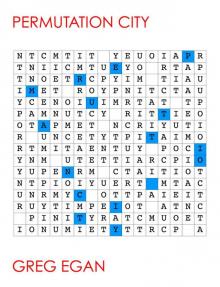 Permutation City
Permutation City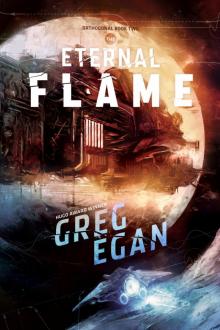 The Eternal Flame
The Eternal Flame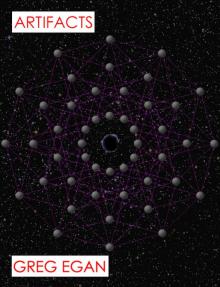 Artifacts
Artifacts Wang's Carpets
Wang's Carpets Dichronauts
Dichronauts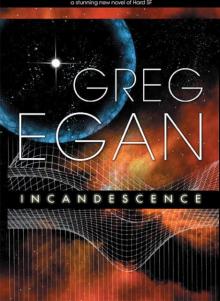 Incandescence
Incandescence Teranesia
Teranesia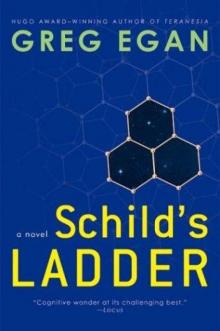 Schild's Ladder
Schild's Ladder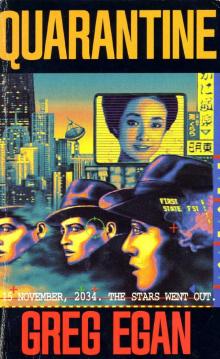 Quarantine
Quarantine The Four Thousand, the Eight Hundred
The Four Thousand, the Eight Hundred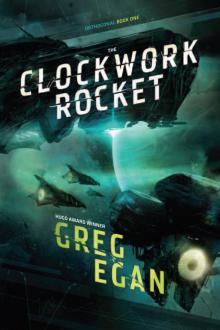 The Clockwork Rocket
The Clockwork Rocket Zeitgeber
Zeitgeber Phoresis
Phoresis The Nearest
The Nearest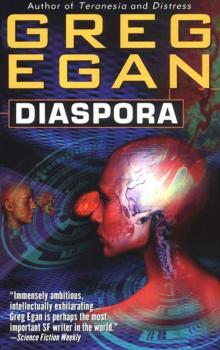 Diaspora
Diaspora Instantiation
Instantiation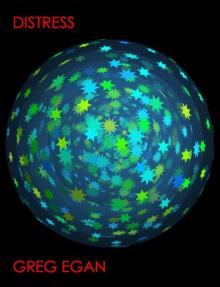 Distress
Distress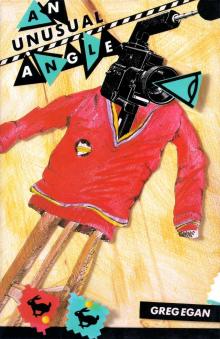 An Unusual Angle
An Unusual Angle Oceanic
Oceanic The Arrows of Time
The Arrows of Time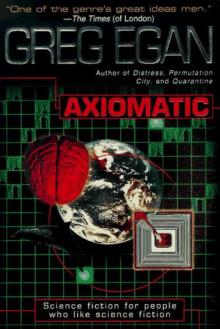 Axiomatic
Axiomatic![Anthology 2. Luminous [1998, 2010] Read online](http://i1.bookreadfree.com/i/03/18/anthology_2_luminous_1998_2010_preview.jpg) Anthology 2. Luminous [1998, 2010]
Anthology 2. Luminous [1998, 2010] Perihelion Summer
Perihelion Summer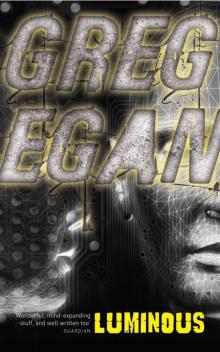 Luminous
Luminous